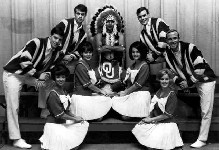Sooners

"Little Red" and the OU Cheersquad, 1967
The University of Oklahoma has a very conflicted history when it comes to its relationship with Native Americans. The school's nickname, "Sooners," is derived from the Oklahoma land runs of 1889, during which white settlers moving westward could claim land. (Previous attempts to settle the land had been stalled by the federal government). All participants in the land run were supposed to leave at the same time. However, some crossed early, thus becoming known as "Sooners." Oklahomans "adopted the nickname as a badge of pride and progressivism," (Blochowiak, 2007) and today, the name "Sooners" refers to a 'go-getter,' a trailblazer, someone accustomed to being first—at least, it does for many. However, for many Native people in the state of Oklahoma, "Sooners" still invokes memories passed down through generations of white settlers who literally ran in and claimed the land previously promised to the Native groups by the federal government. Even worse, the "Sooners" cheated, as did the "Boomers" who claimed land that had already been staked by other white land run participants. This reminder was only made more clear from the 1940s until 1970, a time when "Little Red," an American Indian, danced on the sidelines of OU football games. Eventually, outcry from students and the Native population led to Little Red’s banishment in 1970, and the current Sooner Schooner was adopted. Race, however, had become a casual representative marker. Reminders of this history permeate the campus in photographs and sculptures, including those of its mascots (http://libraries.ou.edu/locations/docs/westhist/Football/mascot.html).
It is safe to say that the "Sooners" nickname is not going anywhere, at least not anytime soon. Generations of Sooners filled with "Sooner Pride" and the national success of OU’s athletic teams have made it a name known through the country. This pride, however, is built on the history of the colonization of the western United States that remains largely unspoken and unquestioned. But to see the name Sooner in light of its implications on racial divisions is difficult for students when everything about the University's culture is predicated on pride in this name. The name just is - it is not representative of anything serious, the thought goes. But rhetorically, the name always serves a broader purpose. Here, it is synecdoche, representing a whole of colonial history that must be addressed (Villanueva, 2006).
Further complicating the relationship is the fact that the university currently has a Native American Studies program that is considered one of the best in the nation. Across campus are spread dozens of examples of Native American art, in the library, various academic halls, and even outside, in the form of sculptures. The University, much like the state, celebrates and perhaps even boasts of the presence of Native culture. However, the history of the University, founded upon soil originally deemed Indian Territory, identified by a nickname that some Native people still refuse to support, makes for a complicated racial environment that seemingly goes unnoticed by non-Native people.